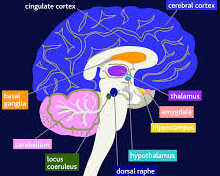Criterion for Generalized anxiety disorder
Anxiety disorders are severe medical illnesses that fill people's lives with overwhelming anxiety and fear. It is a characteristic of many behavior disorders. It is usually concealed by the defensive behaviors.
Generalized anxiety disorder (GAD) is much more than the common anxiety which people feel in day-to-day life. Patients with generalized anxiety disorder experience worry or nervousness and a number of physical and psychological symptoms.
The disorder is normally difficult to diagnose because of the
variety of presentations and the common occurrence of comorbid
medical or psychiatric conditions. It's chronic and makes life
tough even though there is little or nothing to provoke it.

Having this disorder means always expecting disaster, often worrying excessively about health, money, family, or work. Sometimes, though, the source of the worry is hard to identify. Simply the thought of getting through the day, provokes anxiety.
People with normal anxiety have irregular worry about circumstantial events, such as an exam or break-up that may leave you upset. They feel embarrassment or self-consciousness in the face of uncomfortable social situations. In normal anxiety, random case of "nerves" or jitters, dizziness and/or sweating over an important event like an exam or oral presentation. This happens when people are trapped in realistic fear of a threatening object, place or situation and wanting to be sure that they're healthy and living in a safe, hazard-free environment. It can occur any time in the life span of an individual. This is mild and superficial and need only a reason to eradicate the threatening situation by means of defense mechanism.
People with normal anxiety come out from circumstances through
their own logical analysis and no treatment is needed. The scene
is quite different in case of generalized anxiety disorder.

Individuals with GAD seem incapable to relax, and they may frighten more easily than other people. Often, they have trouble falling or staying asleep. GAD doesn't characteristically avoid certain situations as a result of their disorder. When impairment associated with GAD is mild, people with the disorder may be able to function in social settings or on the job. If severe, however, GAD can be very debilitating, making it difficult to carry out even the most ordinary daily activities.
The disorder comes on gradually and can begin across the life cycle, though the danger is highest between childhood and middle age. It can be distinguished from normal anxiety because in GAD, there is avoidance of common social situations for fear of being judged, embarrassed or humiliated and repeated, random panic attacks or persistent worry/anticipation of another panic attack and feelings. They perform unmanageable, repetitive actions, such as washing their hands repeatedly or checking things over and over whereas in normal anxiety, people suffer sadness or difficulty sleeping immediately following a traumatic event.
Treatment techniques for patient of GAD are psychotherapies and social attention which plays a significant role and rewards the patient for making efforts to get rid of disorders.
Email :
kalpstava@yahoo.com
Contributed by Ragini Sinha
Articles on Health
- Laparoscopic Surgery Advantages
- Laparoscopic Surgery History
- Laparoscopic surgery Procedures
- Limitations of traditional laparoscopic surgery
- New technologies for advance laparoscopic surgery
- Non-Robotic Laparoscopic Surgery
- Robotic Laparoscopic Surgery
- Causes and remedy for dark circles in females

- Harmful impact of mobile phone on unborn baby

- Maternal health care tips

- Rheumatoid Arthritis is Most Widespread in Female
- Periodontal ailment during Pregnancy
- Anemia is prevalent in Women
- Effect of Cell phone tower radiation on human health

- Current health scenario india
- Government health policies india
- Medical facilities india
- Hospital infrastructure india
- Shortage of Medical Professionals in India
- Quality standards indian hospitals
- Indian states health statistics
- Medical expenses india
- Hospitals in Ahmedabad
- Hospitals in Bangalore
- Hospitals in Chennai
- Hospitals in Cochin
- Hospitals in Delhi
- Hospitals in Hyderabad
- Hospitals in Kolkata
- Hospitals in Mumbai
- Hospitals in Pune
- Hospitals in Coimbatore
- Hospitals in Kochi
- Orthopaedics Hospitals in India
- Diabetology Hospitals in India
- Cardiology Hospitals in India
- Infertility Hospitals in India
- Neurology Hospitals in India
- Paediatrics Hospitals in India
- Nephrology Hospitals in India
- Oncology Hospitals in India
- Antiaging foods to improve skin

- Tips for Maintaining healthy bones
- Guidelines for preventing heart disease
- Tips to reduce eye strain while working on computer
- Mental health problems among elderly people
- Health problem of piles

- Health advices for air travel

- Dealing with Allergies
- Tips for Eyes Care
- Care for Crystal Clear Skin
- Tips For Healthy Hair
- Healthy Living is The Absolute Measure of Happiness
- Let Fragrance Rule Your Summer
- Most common vestibular disorder

- Osteoporosis Risk Factors
- Dengue

- Endocrine disorder

- Causes of liver damage
- Dry eye syndrome
- Kidney Stones
- Conjunctivitis: Irritating eye disease
- Anxiety Disorder
- Causes of Brain Damage
- Hepititis B
- Knowledge of Osteoarthritis
- Mental Illness
- Back Pain
- Sugar Addiction
- Diet Control Plans
- General Motors Diet Plan
- No Carbohydrate Diet
- One day Diet Plans
- Seven day diet Plans
- Vegetarian Diet
- Food for Health
- Genetically Modified Foods
- Healing Effects Of Fruits
- Vegetables That Heal
- Healing Effects Of Spices and Herbs
- Test your Stress Level
- Mantras for Relaxation & Stress free life
- Take walk For a healthy body and mind
- Squint is frequently observed in Children
- Consult-Doctor
- Free Handy Health Advice